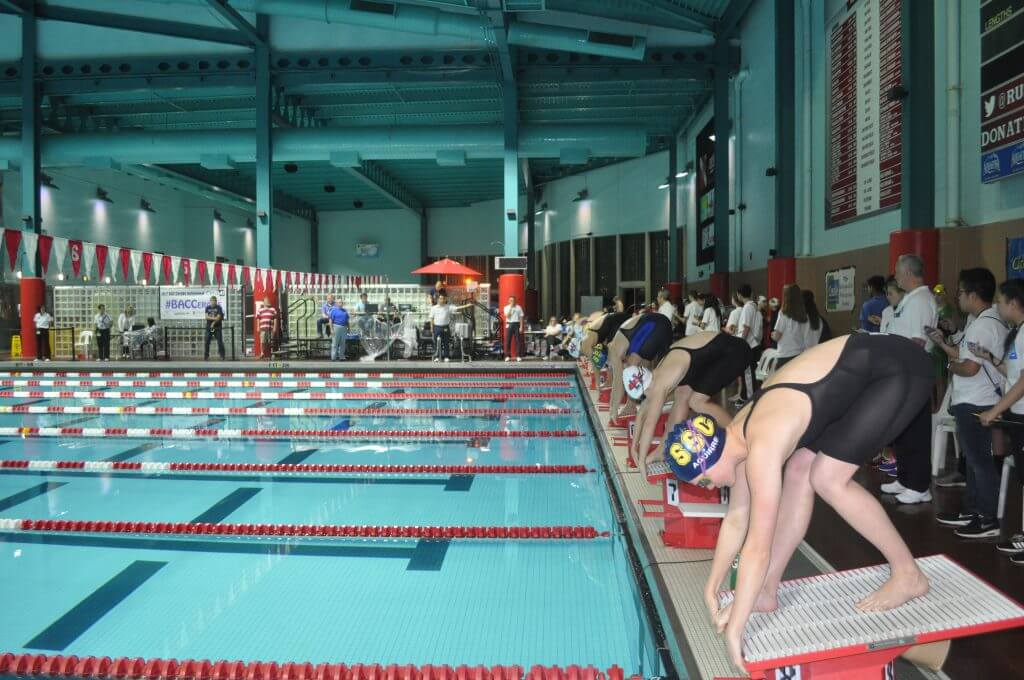Olympians Leave Behind Legacy at CeraVe Invitational

By Emma Miller, Swimming World Intern.
In the world of swimming – local, national and international – Jim Wood is nothing less than a legend. He has been coaching since 1972 and is a former president of USA Swimming as well as a member of the U.S. Swimming Olympics International Operations Committee.
This weekend, Wood had the opportunity to reflect on how the CeraVe Invitational has developed since he started the meet in 1991.
“It didn’t take very long for it to become high-level,” Wood said. “It’s been a pretty high-standard meet for around 20 years. We’ve grown not necessarily in size but in quality.”
The invitational is one of very few long course meets that takes place during the winter season. Traditionally, swimmers train in short course yards during the fall and winter, transitioning to long course meters over the summer. It is exactly this reason that Wood started this meet with fellow coaches at Berkeley Aquatic Club.
“The reason that we started it was because I thought there was a real lack of 50-meter quality competition during the winter,” he explained. “Obviously, all of the major competitions in the world – the World Championships, the Olympic Games – they’re all 50 meters.”
The appeal of being able to race long course during the short course season has drawn in some prominent athletes over the years. World record-holder and U.S. gold medalist Katie Ledecky competed at the meet for Nation’s Capital Swim Club, and even Michael Phelps has made an appearance here.
“I think Michael Phelps won as a 10-and-under,” Wood said, chuckling. “It was the 10-and-under 50 butterfly. I’m gonna say [the record] might’ve been 33-something.”
Wood didn’t give 9-year-old Phelps enough credit – his time was actually 32.39 when he swam back in 1995.
Other U.S. Olympians who have swum at the CeraVe Invitational also made their marks on the record books, including Katie Hoff of North Baltimore, who still holds the meet record in the Women’s 100 free with 56.00, and Lea Maurer of Badger, whose 1:02.13 in the Women’s 100 back is the fastest the meet has seen. Olympians Anita Nall, Elizabeth Beisel and Tom Wilkens hold meet records as well.
“It’s been good watching all those swimmers go through,” Wood commented. “Because of my role with the [United States] Olympic Committee for a while, I got to know a lot of these kids. Some of them come back and say, ‘That was an instrumental meet for me.’ That’s been really good to hear.”
Looking to the future, there are several swimmers competing this year who will likely become influential down the road.
17-year-old Carly Cummings from Badger made the 2016 Olympic Trials in four different events, and she placed second in both the 200 breast and 200 IM, though she didn’t lose by much. Alex Sumner of the Suburban Seahawks made her presence known, notching victories in the 200 IM and the 100 back. Her best is still to come, though, as she is favored to win the 200 back in finals tonight.
Easop Lee brought home four wins for North Baltimore in the 50, 200 and 400 free as well as the 100 fly. Then there’s Long Island’s Kristen Romano, who used last year’s CeraVe meet as a springboard to Olympic Trials but had to pull out of this year’s meet after Friday morning prelims when she became sick.
For the men, Jason Louser of Long Island placed first overall in the 100 breast, giving us a glimpse at what he’s capable of down the line; at only 15 years old, Louser was also a top contender in several other finals. Delaware’s Jake Johnson was responsible for a dramatic win during the butterfly leg of the 400 IM relay, but also captured individual wins in the 100 fly and 100 back. NBAC’s Billy Cadigan captured hard-fought wins in the 400 IM and 200 free.
“I think with clubs like Bluefish, Long Island, North Baltimore, Badger – those are all clubs that have been pretty successful internationally,” said Wood. “The fact that they come back year after year shows that it’s helping their athletes.”
North Baltimore, of course, has pumped out swimmers like Phelps and Hoff thanks to the contributions from coach Paul Yetter. It was under Yetter that Hoff broke eleven American records during the 2007-08 season, eventually winning a silver medal and two bronze at the Beijing Olympics. John Collins of Badger, meanwhile, helped Cody Miller train for the Rio Olympics, where he won an individual bronze medal and a gold medal in the 400 medley relay.
Despite the growing number of winter long course meets, Wood says he’s not worried about the future of the CeraVe Invitational.
“Nowadays, there’s Grand Prix meets that people can travel to, but you can’t bring a whole team for other reasons, so we still get lots of support here,” said Wood. “We really tailor the meet towards [like-minded] clubs. They’re very oriented towards long course swimming, so we wanted to offer that as an opportunity. The folks coming here 25 years ago are still the ones coming now.”
All commentaries are the opinion of the author and do not necessarily reflect the views of Swimming World Magazine nor its staff.




